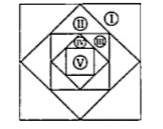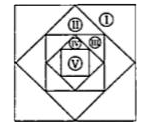In the figure shown square II is formed by joining the mid-points of square I

and so on . In this way total five squares are drawn . The sides of the square I is 'a' cm.
What is the perimeter of all the five squres ?
(4√2+1)a(√2+1)
56a
(7+3√2)a
None of these
The correct Answer is:C
Step by step video, text & image solution for In the figure shown square II is formed by joining the mid-points of square I and so on . In this way total five squares are drawn . The sides of the square I is 'a' cm. What is the perimeter of all the five squres ? by Maths experts to help you in doubts & scoring excellent marks in Class 9 exams.
Updated on:21/07/2023Topper's Solved these Questions
- IMO QUESTION PAPER 2016 SET A BOOK - SCIENCE OLYMPIAD FOUNDATION CHAPTER - IMO QUESTION PAPER 2016 SET A EXERCISE - Everyday Mathematics
10 Videos
- IMO QUESTION PAPER 2016 SET A BOOK - SCIENCE OLYMPIAD FOUNDATION CHAPTER - IMO QUESTION PAPER 2016 SET A EXERCISE - Achievers Section
5 Videos
- HERON'S FORMULABOOK - SCIENCE OLYMPIAD FOUNDATION CHAPTER - HERON'S FORMULAEXERCISE - Achievers Section (HOTS)
3 Videos
- IMO QUESTION PAPER 2016 SET BBOOK - SCIENCE OLYMPIAD FOUNDATION CHAPTER - IMO QUESTION PAPER 2016 SET BEXERCISE - Achievers section
5 Videos
Similar Questions
Knowledge Check
In the figure shown square II is formed by joining the mid-points of square II

and so on . In this way total five squares are drawn . The sides of the square I is 'a' cm.
What is the total area of all the five squares ?A(4√2−1)a2(4√2−1)B(4√2−1)a24(√2−1)C3116a3Dnone of theseEach side of a square measures 5.6 cm. The perimeter of the square is ______ .
A23.5 cmB22 cmC22.4 cmD22.4cm2What should be side of square (in cm.) if its perimeter is equal to area?
A6cmB2cmC4 cmD8 cm
Show that the quadrilateral, formed by joining the mid-points of the sides of a square is also a square.
View SolutionIf one side of a square is 4 cm, then what will be its area and perimeter?
View SolutionThe length of side of a square is 'a' metre. A second square is formed by joining the middle points of this square. Then a third square is formed by joining the middle points of the sides of the second square and so on. Then, the sum of the areas of squares which carried upto infinity, is
View SolutionIf the perimeter of a square is 44 cm, what is the diagonal (in cm) of the square ?
View SolutionIf the perimeter of a square is 44 cm, what is the diagonal (in cm) of the square ?
View Solution
